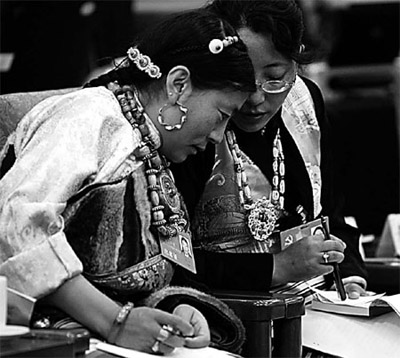Rapid tourism growth will not necessarily be detrimental to the environment, as the two can develop harmoniously, officials from Tibet said yesterday.
By the end of this month's national holiday, the number of visitors to the autonomous region had risen to 3.5 million, up from 2.5 million last year, Hao Peng, deputy Party secretary of Tibet, said.
Lun Zu (left) and Deji Zhuosang, delegates from the Tibet Autonomous Region attending the 17th Party Congress, yesterday discuss the political report delivered by Hu Jintao on Monday.
At a group discussion during the 17th Party Congress, Hao praised the Qinghai-Tibet Railway as "an economic, united, ecological and happy line".
He explained it has enhanced relations between Tibet and other parts of China after it went into service last July, and moreover, has had an enormous impact on Tibet's tourism industry.
He estimated the total tourism revenue will reach more than 4 billion yuan (US$530 million) this year.
Many local people have benefited, especially those running businesses in scenic spots and alongside the railway, he said.
Hao said the average annual income of a Tibetan farmer will be 2,700 yuan this year, up 17 percent on 2006.
He denied tourism might become over-developed and affect the environment.
"Tourism is the most environment-friendly industry," he said.
He said the government had paid considerable attention to environmental protection while developing the region's tourism industry.
"Lhasa, for example, is the first city in China to abolish the use of white plastic bags. And there are always residents and officers prepared to pick up garbage at scenic spots."
Hao also compared the situation to neighboring Yunnan Province, which welcomed about 50 million tourists last year.
"Compared with our neighbor, the number of tourists to Tibet is very small. In my opinion, tourism here has lots of potential," he said.
Qiangba Puncog, chairman of the regional government of Tibet, said the refurbishment of Potala Palace will soon be completed. As for how to protect the site, which dates back more than 1,300 years, he said visitor numbers had recently been limited to no more than 3,000 every day.
An exhibition house is being built to allow more visitors to see several pieces from the palace without having to enter the site.
(China Daily October 17, 2007)






